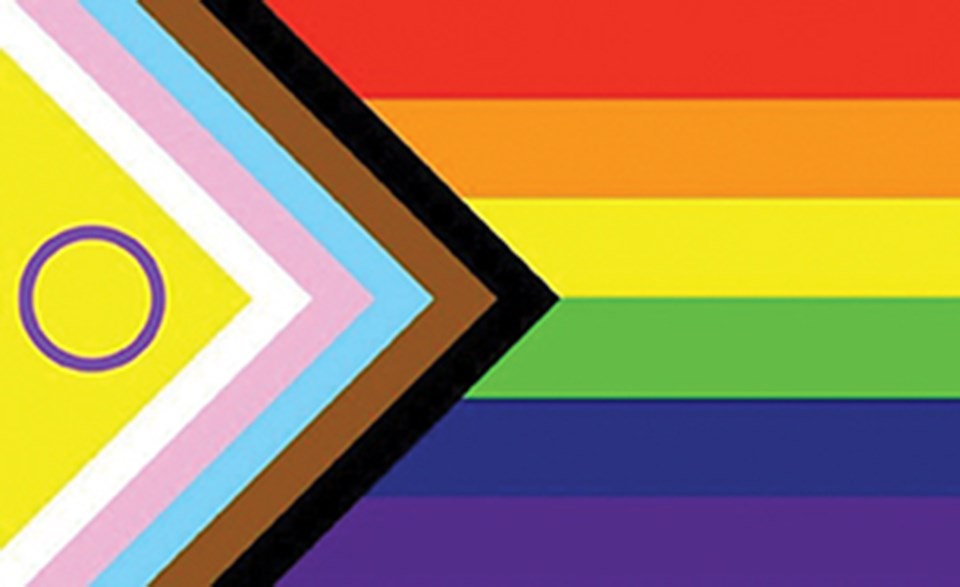It’s not just a regular rainbow anymore.
If you take a look at the Pride flags being displayed around Squamish this month, you may notice some alterations. The most noticeable is a multi-coloured V that points inwards from the left. Originally invented in 2018 and gaining wide acceptance worldwide, the chevron has the colours black and brown included to acknowledge racial diversity alongside pink, baby blue and white to represent trans and non-binary people.
Then, in 2021, the flag was further redesigned to include a purple circle with a yellow backdrop, situated within the earlier triangle. This represents people from the intersex community.
So why were these changes necessary? According to Britt Martell, vice president of Pride Squamish, the design reflects society’s growing acceptance and understanding of gender and sexual diversity.
Martell uses the pronounces they/them.
By visually representing additional groups, they’re further opening up the LGBTQ+ umbrella to make sure everyone has a safe space to be shielded from the hard rain of discrimination.
“As with everything, we’re slowly creating safer places where people can freely be themselves. As a society we’re starting to understand and recognize how diverse we are, and research has gone to show that representation and being able to see who you are represented in the community isn’t just helpful. It’s not just about safe spaces. It’s about saving lives,” they told The Squamish Chief.
“Queer people have been living for a long time in places where threats of violence and harm are real everyday experiences that they have to navigate. So we’re lucky to have a Pride flag that is progressive and evolves with diversity.”
Speaking to the inclusion of the chevron, Martell noted that it is symbolically significant because gay men used to represent themselves with a visually similar pink shape. The addition of colours that represent racial identities acknowledges the effects of intersectionality on marginalized groups, while the white, pink and blue make a firm distinction between gender identity and sexuality — two things that are often erroneously conflated.
They are particularly pleased about the intersex addition.
“An important thing is there’s still so much shame and stigma around intersex people, and we don’t talk about it as community members or as humans, but it’s a very real way of existence and there’s nothing wrong with it. We’re growing from times where it wasn’t safe to be yourself, where any difference was reacted to with fear,” they said.
“Creating safe spaces starts with acknowledging who we are.”
And the flag isn’t the only thing that’s changing. Pride Squamish is in early talks with Squamish Nation about whether they should change the acronym that describes their community from LGBTQ+ to 2SLGBTQ+, a move that would put two-spirited folks at the forefront.
Martell emphasized that they are not an expert on the subject of two-spiritism, and is eager to learn more during the discussion process, but understands that this particular identity predates colonization.
“The really special thing about the two-spirit identity is that it pre-existed Western civilization, which was established and practiced throughout Canada and the United States. These are older concepts where you see the gender binary is not something we need to be restricted to. There are other ways of knowing and being, and gender is a form of self-expression. It shows we don’t need to be limited to the roles we’re restricted to.”
Pride Squamish has moved away from having an annual parade, partially because there are successful events in Whistler and Vancouver. Instead they’re putting their efforts into offering year-round programming and events, which are listed on their website calendar.
According to Martell, the organization believes they have more work to do in the community before parade participants would be able to feel safe. They said raising awareness about the complexity of gender and sexuality can be a time-consuming and thankless endeavour, but you have to stand up to discrimination.
“I look forward to a day when we can all relate to each other as human beings and recognize as community members that we’re all connected. One person’s way of life doesn’t need to interfere or negatively impact yours, and there is space for everyone to be their authentic self.”
To learn more about Pride Squamish or to get involved, visit pridesquamish.com.
**Please note, this story has been corrected since it was first posted to use the accurate pronouns of Britt Martell: they, them.




